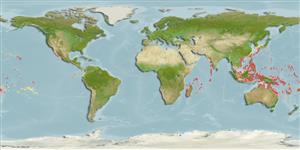Common names from other countries
>
Gobiiformes (Gobies) >
Gobiidae (Gobies) > Gobiinae
Etymology: Eviota: No etymology given, suggested by Christopher Scharpt: from Latin 'eu' for 'true' and 'iota' for anything very small, in combination 'truly very small' referring to it as being the smallest vertebrate at the time it has benn described by Jenkins (thus, making the suggestion by Scharpt plausible..
More on author: Smith.
Environment: milieu / climate zone / depth range / distribution range
นิเวศวิทยา
เกี่ยวกับทะเล,น้ำเค็ม เกี่ยวกับหินโสโครก; ระดับความลึก 0 - 18 m (Ref. 86942). Tropical
Indo-Pacific: from the East African coast (Mozambique) and Seychelles, Aldabra, and Chagos; the East Indian region; southward to Australia; north to Japan and Micronesia (Palau, Guam, Northern Mariana Islands, Federated States of Micronesia, Marshall Islands, and Kiribati [Line Islands]), and east to French Polynesia (Society Islands).
ขนาด / น้ำหนัก / Age
Maturity: Lm ? range ? - ? cm
Max length : 1.9 cm SL เพศผู้/กระเทย; (Ref. 1602)
Short description
เครื่องมือที่ใช้ในการแยกชนิดสัตว์,สิ่งมีชีวิตออกจากกัน | สัณฐานวิทยา | ความยาวต่างๆ
เงี่ยงครีบหลัง (รวม) : 7; ก้านครีบอ่อนที่หาง (รวม) : 8; เงี่ยงครีบก้น: 1; ก้านครีบอ่อนที่ก้น: 8 - 9. Characterized by semi-transparent, greenish-brown body with about six faint, internal dark bars; scale margins narrow orange-brown; short brown bars across top of head and along upper back; presence of dark internal blotches above anal fin and lower edge of caudal peduncle; upper portion of caudal peduncle with large black spot; eleventh to fifteenth pectoral rays usually branched; ctenoid scales, absent on head, nape and pectoral fin base; longitudinal scale series 23-24; separated pelvic fins, thin membrane joining bases; rudimentary fifth pelvic ray; average of 6-7 branches on fourth pelvic ray; depth of body 3.6-4.2 in SL (Ref. 90102). Dorsal to anal fin-ray formula 8/8.
Inhabits shallow coral reefs to about 10 m (Ref 90102).
Life cycle and mating behavior
Maturities | การสืบพันธุ์ | Spawnings | Egg(s) | Fecundities | ตัวอ่อน
Myers, R.F., 1991. Micronesian reef fishes. Second Ed. Coral Graphics, Barrigada, Guam. 298 p. (Ref. 1602)
IUCN Red List Status (Ref. 130435)
CITES (Ref. 128078)
Not Evaluated
Threat to humans
Harmless
Human uses
เครื่องมือ
Special reports
Download XML
แหล่งที่มาจากอินเตอร์เน็ต
Estimates based on models
Preferred temperature (Ref.
115969): 24.7 - 29.3, mean 28.2 (based on 2315 cells).
Phylogenetic diversity index (Ref.
82804): PD
50 = 0.5000 [Uniqueness, from 0.5 = low to 2.0 = high].
Bayesian length-weight: a=0.00708 (0.00333 - 0.01504), b=3.09 (2.92 - 3.26), in cm Total Length, based on LWR estimates for this (Sub)family-body shape (Ref.
93245).
ระดับชั้นอาหาร (Ref.
69278): 3.0 ±0.3 se; based on size and trophs of closest relatives
ความสามารถในการกลับคืนสู่ปกติ (Ref.
120179): ความสูง, เวลาต่ำสุดที่จะทำให้ประชากรเพิ่มขึ้นเป็น 2 เท่าใช้เวลาน้อยกว่า 15 เดือน (Preliminary K or Fecundity.).
Fishing Vulnerability (Ref.
59153): Low vulnerability (10 of 100).
